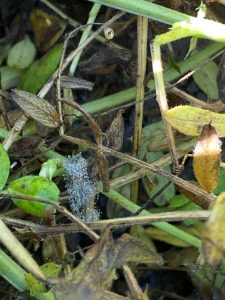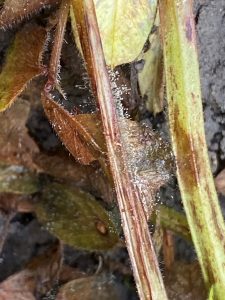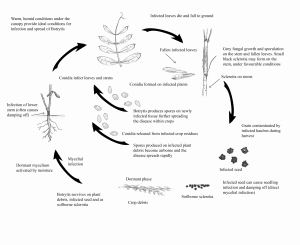Botrytis grey mould of vetch is a foliar disease caused by the fungal pathogens Botrytis cinerea and Botrytis fabae. Botrytis grey mould (BGM) of vetch is a significant risk to both grain and hay yield and quality losses especially if crops are sown early. The purpose of growing vetch is usually to have large canopies/biomass which in turn intensifies the disease risk with the canopy micro-climate ideal for disease progression.
What to look for
The disease can infect all above ground parts of the vetch plant, including leaves, stems, flowers and pods. The first symptoms are discrete greyish-brown lesions on the lower leaves of the plant. However, no black fruiting bodies are produced within the lesions. Infected leaves can become covered with a fluffy layer of grey mould toward the base of the plant. Stem lesions will appear light-brown or bleached and can be covered in grey, mouldy growth. The mouldy growth consists of spore masses that can quickly spread to infect surrounding plants. Clouds of spores can visibly rise from infected plants if they are disturbed.
Often in vetch there may be no lesions present, but the first signs may be a fluffy layer of grey mould where the leaves have senesced (hayed off) due to lack of light and the fungus has colonised this material. This can then act as a reservoir for the disease to infect the rest of the crop.
Dark black fungal survival bodies, known as sclerotia, can develop on stems and it is these structures that survive over summer on vetch stubble and in the soil. Severely infected leaves, flowers and pods wilt and fall to the ground. Plants ripen prematurely due to infection of the lower stem. If conditions remain wet throughout spring, stems can become girdled and patches of brown dying plants appear in the crop. If the canopy dries out later in the season and there is still good soil moisture, it is possible for the crop to grow away from the infection. However, there may still be palatability issues for stock and there is a good chance of reinfection when moisture returns to the canopy.
Infected pods will fail to fill properly and will produce shrivelled seed or no seed at all. Infected seed is discoloured.

First symptoms of Botrytis grey mould in vetch showing greyish-brown lesions across leaves lower in the canopy (Photo: Joshua Fanning — Agriculture Victoria)

First symptoms of Botrytis grey mould in vetch showing greyish-brown lesions with no pycnidia (black fruiting bodies within the lesion).
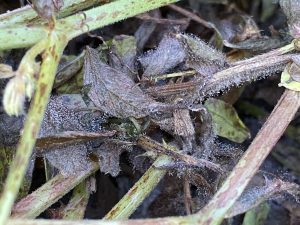
Senesced (hayed off) vetch leaves due to lack of light covered in a fluffy layer of grey mould (botrytis grey mould), close to the ground
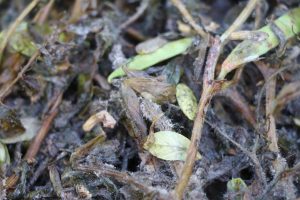
Senesced (hayed off) vetch leaves due to lack of light covered in a fluffy layer of grey mould (botrytis grey mould), close to the ground
Disease Cycle
The disease inoculum readily survives on faba bean (Botrytis fabae) and chickpea (Botrytis cinerea), lentil and vetch (B. fabae and B. cinerea). The pathogens can survive on stubble residue (vetch, lentil, chickpea or faba bean), in the soil as sclerotia, or can be carried on infected seed. When seed infected by these fungi are sown seedling blight will occur soon after crop emergence, reducing plant populations. Masses of spores are produced on infected plants which can then spread onto surrounding plants by wind and rain-splash to begin new infections.
Symptoms of grey mould appear more commonly in early spring following canopy closure. Dense crop canopies combined with warm, wet conditions in late winter and early spring favour the development and spread of the disease. Often symptoms of BGM first appear in double sown areas of the crop.
Moisture within the crop canopy is essential for infection which is more likely in high biomass canopies. Vetch crops are usually sown before most other crops developing high biomass canopies, and therefore have a higher risk of developing BGM. Pushing the sowing window earlier or sowing at high seeding rates will further increase the biomass and therefore the risk of BGM developing. The disease usually starts off affecting lower leaves and the base of the stem. Prolonged wet conditions during the growing season can cause the disease to progress higher up the plant, subsequently affecting pods.
Management
Although most vetch varieties are susceptible to BGM there are several management practices which can be utilised to reduce disease severity in vetch crops.
Cultural Practices
Crop rotation
As the same pathogens cause BGM in vetch, faba bean, lentil and chickpea this needs to be considered when planning rotations to allow sufficient time for stubble breakdown between affected crops. This time will vary between rainfall zones. Allow the previous potentially infested stubble to break down completely and ideally allow an additional one-year break before vetch is planted in the same paddock.
Time of sowing
Time of sowing can help to determine when canopy closure occurs which can impact the effectiveness of fungicides. If crops are sown too early and not grazed, canopy closure can occur early, not allowing foliar fungicide penetration into the crop. If canopy closure occurs too early in winter, the fungicide application at canopy closure may not protect the crop when environmental conditions favour rapid disease development when BGM starts to spread in early spring.
Grazing
Grazing may open the canopy to reduce the canopy humidity and thus reduce the disease risk. This may be particularly relevant in early sown crops.
Variety Selection
There is limited variation in resistance within current vetch varieties and there are currently no varieties resistant to BGM. Check the latest pulse disease ratings for the up to date ratings.
Fungicides
The use of foliar fungicides can be expensive, and in a crop which is often used as a manure or grazing crop, fungicides may not be warranted.
Due to the susceptibility of vetch varieties, fungicides will likely be required to prevent disease in vetch crops if they are to be cut for hay or harvested for grain. In susceptible crops, preventing BGM is very important as it is a very aggressive disease and can spread quickly across a paddock. Therefore, a preventative disease management program is better than a curative program. A foliar fungicide applied just prior to canopy closure to prevent disease development is the most effective timing. Multiple fungicides may be required in vetch due to the early sowing. However, it is always important to consider the end use of the crops and only apply fungicides where it is essential to reduce the chance of fungicide resistance developing.
In other crops, some newer released fungicides have provided longer protection against disease and may also provide longer protection in vetch. In conducive disease years, multiple fungicides may be required. It is important to check product registrations and withholding periods, especially when the vetch crop is to be consumed by livestock.
Fungicides should always be applied according to label directions for use, ensuring the key points of spray timing and frequency are observed as well as grazing and harvest withholding periods.
In Victoria, some fungicides are known as ‘restricted use’ chemicals. Chemical licensing is required to use these chemicals. To find out more information about restricted use chemicals and chemical licensing requirements, please visit: agriculture.vic.gov.au/chemicals

